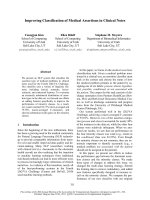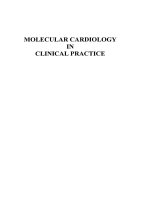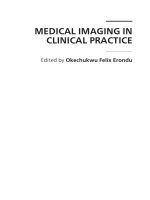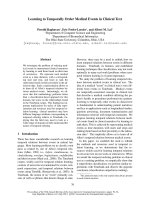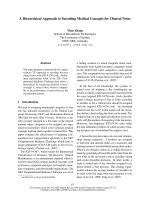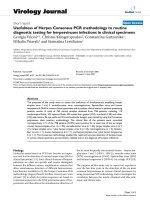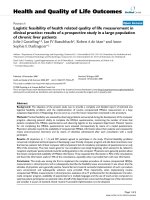MEDICAL IMAGING IN CLINICAL PRACTICE docx
Bạn đang xem bản rút gọn của tài liệu. Xem và tải ngay bản đầy đủ của tài liệu tại đây (32.95 MB, 362 trang )
MEDICAL IMAGING IN
CLINICAL PRACTICE
Edited by Okechukwu Felix Erondu
Medical Imaging in Clinical Practice
/>Edited by Okechukwu Felix Erondu
Contributors
Zongjin Li, Mojtaba Salouti, Akram Fazli, Marco Antonio Gutierrez, Francesco Alessandrino, Alfredo La Fianza, Giorgia
Ricci, Esmeralda Eshja, Francesco Alfano, Carolina Della Fiore, Chiara Cassani, Carlos Costa, Frederico Valente, Augusto
Silva, Patricia Carreño Moran, Julian Breeze, Michael Rees, Sonia Marta Moriguchi, Paulo Henrique Alves Togni, Katia
Hiromoto Koga, Marcelo Santos, Tsuicheng D. Chiu, Takuya Osada, Laurence B Lovat, Rehan Haidry, Martín Gallegos-
Duarte, Okechukwu Felix Erondu, Begona Garcia Zapirain, Maria Viqueira, Amaia Mendez Zorrilla
Published by InTech
Janeza Trdine 9, 51000 Rijeka, Croatia
Copyright © 2013 InTech
All chapters are Open Access distributed under the Creative Commons Attribution 3.0 license, which allows users to
download, copy and build upon published articles even for commercial purposes, as long as the author and publisher
are properly credited, which ensures maximum dissemination and a wider impact of our publications. After this work
has been published by InTech, authors have the right to republish it, in whole or part, in any publication of which they
are the author, and to make other personal use of the work. Any republication, referencing or personal use of the
work must explicitly identify the original source.
Notice
Statements and opinions expressed in the chapters are these of the individual contributors and not necessarily those
of the editors or publisher. No responsibility is accepted for the accuracy of information contained in the published
chapters. The publisher assumes no responsibility for any damage or injury to persons or property arising out of the
use of any materials, instructions, methods or ideas contained in the book.
Publishing Process Manager Danijela Duric
Technical Editor InTech DTP team
Cover InTech Design team
First published February, 2013
Printed in Croatia
A free online edition of this book is available at www.intechopen.com
Additional hard copies can be obtained from
Medical Imaging in Clinical Practice, Edited by Okechukwu Felix Erondu
p. cm.
ISBN 978-953-51-0986-0
free online editions of InTech
Books and Journals can be found at
www.intechopen.com
Contents
Preface VII
Section 1 General Perspectives in Medical Imaging 1
Chapter 1 Content Based Retrieval Systems in a Clinical Context 3
Frederico Valente, Carlos Costa and Augusto Silva
Chapter 2 Challenges and Peculiarities of Paediatric Imaging 23
Okechukwu Felix Erondu
Chapter 3 Clinical Applications of Nuclear Medicine 37
Sonia Marta Moriguchi, Kátia Hiromoto Koga, Paulo Henrique Alves
Togni and Marcelo José dos Santos
Chapter 4 Current Perspectives on Molecular Imaging for Tracking Stem
Cell Therapy 63
Lingling Tong, Hui Zhao, Zuoxiang He and Zongjin Li
Section 2 Innovations in Medical Imaging Techniques 81
Chapter 5 Spin Average Supercompound Ultrasonography 83
Tsuicheng D. Chiu, Sonia Contreras and Martin Fox
Chapter 6 Ocular Movement and Cardiac Rhythm Control using EEG
Techniques 113
María Viqueira, Begoña García Zapirain and Amaia Mendez Zorrilla
Chapter 7 Novel Imaging Techniques in Gastrointestinal Endoscopy in the
Upper Gastrointestinal Tract 137
Rehan Haidry and Laurence Lovat
Chapter 8 Vocal Folds Stroboscopic Image Processing for
Otolaryngology 175
A. Méndez Zorrilla and B. García Zapirain
Chapter 9 Infectious Foci Imaging with Targeting Radiopharmaceuticals
in Nuclear Medicine 193
Mojtaba Salouti and Akram Fazli
Section 3 Specific Clinical Applications 231
Chapter 10 Quantitative Assessment of Peripheral Arteries in
Ultrasound Images 233
Marco Antonio Gutierrez, Maurício Higa, Paulo Eduardo Pilon,
Marina de Sá Rebelo and Silvia Gelás Lage
Chapter 11 The Top Ten Cases in Cardiac MRI and the Most Important
Differential Diagnoses 253
Patricia Carreño-Morán, Julian Breeze and Michael R. Rees
Chapter 12 Determination for the Comprehensive Arterial Inflows in the
Lower Abdomen Assessed by Doppler Ultrasound:
Methodology, Physiological Validity and Perspective 283
Takuya Osada
Chapter 13 Plasticity of the Visual Pathway and Neuroimaging 307
M. Gallegos-Duarte, S. Moguel-Ancheita, J.D. Mendiola-
Santibañez, V. Morales-Tlalpan and C. Saldaña
Chapter 14 Differential Diagnosis for Female Pelvic Masses 327
Francesco Alessandrino, Carolina Dellafiore, Esmeralda Eshja,
Francesco Alfano, Giorgia Ricci, Chiara Cassani and Alfredo La
Fianza
ContentsVI
Preface
Everyday, millions of medical images are produced worldwide, to aid diagnosis and treat‐
ment of patients. A typical patient’s diagnostic work-up is often incomplete without a medi‐
cal imaging technique. The various techniques for achieving this have continued to evolve,
from the basics through the sophisticated and now to the abstract. The concept of Medical
imaging has therefore continued to widen, from the conventional like X-rays, ultrasound,
CT, PET CT, MRI and nuclear Scintigraphy, to include various other recording and meas‐
urement techniques which may be documented by mapping or graphs.
This new book on ‘Medical Imaging in Clinical practice’ is another bold attempt to highlight
the various research efforts and adaptations of newer and emerging techniques in the ever
increasing world of medical Imaging. It seeks to explore the clinical applications of these
newer techniques, while drawing parallels with the more conventional methods. It is by no
means exhaustive, but achieves the overall purpose of widening the scope of knowledge
and the readers’ perception of the amazing world of medical Imaging.
I am sure, that most readers will not only be impressed, but encouraged to explore this ever
evolving specialty of Medical Imaging and the bright hopes it offers in the future of clini‐
cal practice.
Dr. Okechukwu Felix Erondu
University of Nigeria Nsukka, Nigeria
Section 1
General Perspectives in Medical Imaging
Chapter 1
Content Based Retrieval Systems in a Clinical Context
Frederico Valente, Carlos Costa and Augusto Silva
Additional information is available at the end of the chapter
/>1. Introduction
Nowadays, digital images and protocols stand as a cornerstone of most modern health-care
systems where they are used to provide important data and insights into the inner workings
and ailments of the human body. The recent appearance of new modalities, the devices re‐
sponsible for data acquisition, such as the fMRI
1
and the MDCT
2
, produce copious amounts
of data [1]. This, coupled with recent advances in storage technology has had as conse‐
quence an explosion in the amount of data produced at medical imaging institutions. For in‐
stance, the Geneva Hospital alone produced, in 2006, over 50000 images per day and such
numbers are steadily rising [2]. Given the prevalence of digital images and protocols in the
medical arena, we are, nonetheless, still a long way from fully taking advantage of the po‐
tential brought up by this digital revolution. The current data explosion makes it trouble‐
some to a practitioner to sift through the imaging repositories while searching for data
relevant for his context. This means we have the data, but not the information, which should
be readily available to the experts in the area. In fact, data overload has been reported as a
problem by practitioners from medium to large imaging institutions [3].
The current methods of data search, such as the ones provided by the standard query
mechanisms present in Digital Imaging and Communication in Medicine (DICOM) are
sub-optimal, relying on template matching over a limited number of textual fields [4]
(which fields are available depend on the specific software backend), and can conse‐
quently be improved upon. It is expected that, by providing more refined and robust
methods of searching the large image repositories that currently exist, diagnostic accura‐
cy and efficiency can be improved and more accurate and useful Computer Aided Diag‐
nosis (CAD) tools be devised.
1 Functional Magnetic Ressonance Imaging
2 Multi-detector computed tomography
© 2013 Valente et al.; licensee InTech. This is an open access article distributed under the terms of the
Creative Commons Attribution License ( which permits
unrestricted use, distribution, and reproduction in any medium, provided the original work is properly cited.
A promising approach to solve the data explosion problem is to integrate computer-based
assistance into the image querying and storage processes. This brings us into the topic of
Content-Based Image Retrieval (CBIR). At its core, CBIR are a set of techniques to extract rel‐
evant pieces of information directly from an image or multimedia object itself with mini‐
mum (ideally none) intervention from a human.
The overarching goals are to improve the efficiency, accuracy, usability and reliability of
medical imaging services within healthcare enterprises by analyzing content extracted di‐
rectly from raw image data.
2. Picture archive and communication systems
In a medical imaging institution, such as a hospital or a clinic, the set of technologies employed
through the processes of archiving, visualizing, acquiring and distributing medical images
over a computer network (see Figure 1) is commonly referred to as a Picture Archive and Com‐
munication System (PACS). PACS have evolved tremendously since when, as early as 1972,
Dr. Richard J. Steckel implemented a minimal imaging system, comprising not much more
than a scanner next to a film developer for digitalization of radiographs, a communication pro‐
tocol to transmit those images and a video monitor to receive and display them [5]. No more
than a proof of concept back then, but fast forward to current days, however, and a properly in‐
tegrated hospital, or an enterprise PACS implementation is now a major undertaking that re‐
quires careful planning and several million dollars of investment [6]. Such investment is often
required since large PACS commonly have to handle more than 20000 radiological procedures
per year each procedure comprising potentially hundreds of distinct images. This means
around 10 Terabytes of imaging information are stored per year [7]. It is in such situations that
Content Based Image Retrieval systems are expected to provide the largest benefits.
PACS are still a very active field of research where the ever-changing requirements and the
desire to provide more efficient services coupled with new ideas. Figure 2 shows a chrono‐
logical view of the different challenges that arose and of some of the problems in which the
research community is currently focusing. The push for CBIR enabled PACS has gained mo‐
mentum since the late 90’s up to the present day, however, even nowadays there are very
few such systems currently powering medical institutions.
2.1. Digital imaging and communication in medicine
A major step in the direction of modern PACS was given circa 1985 with the creation of an
earlier form of what would become the current DICOM standard. This protocol stands as
one of the key protocols involved in medical imaging systems. We can consider it as the glue
that holds the equipment and software developed by multiple companies together. It is an
expansible, object oriented protocol with support for multiple imaging modalities and re‐
spective structured reports that also allows for private data to be embedded in its objects. Of
great importance is the fact that it defines how medical image data and correspondent meta-
Medical Imaging in Clinical Practice4
data is to be stored, retrieved, and transmitted thus enabling communication between devi‐
ces manufactured by distinct entities within a PACS.
Figure 1. Outline of a PACS infrastructure comprising the most common components in an imaging institution
Figure 2. Evolution of PACS research and current trends
Content Based Retrieval Systems in a Clinical Context
/>5
The protocol, first proposed by the National Electrical Manufacturers Association (NEMA),
in 1983, and currently in its third version, was in itself a major contribution to the exchange
of structured medical data [8]. With most available medical equipment providing embedded
DICOM support, large sets of medical data have been produced in the DICOM file format.
DICOM controls proper image display, it allows a large set of image post-processing from
multi-planar reconstruction to the more advanced perfusion analysis, virtual colonoscopy
and volume segmentation. This protocol can also be leveraged to enable a PACS-independ‐
ent way of performing computer-aided diagnosis [9] and knowledge extraction [10]. In prac‐
tice, much of the ease and flexibility radiologists enjoy today at work is due to this protocol.
However, while DICOM is an open standard, it was created with an eye on the future. As
such, it is not set on stone and addends are continuously being added to support new
services and modalities. DICOM uses an object oriented approach and its functionality
can be extended. This is of great advantage since it allows bridging CBIR with PACS ex‐
panding on the DICOM protocol proving the extra functionality with minimal changes in
infrastructure.
In DICOM, all data is organized in a patient, study, series and images hierarchy. These are
viewed by DICOM as objects with a set of properties or attributes. The definitions for these
objects and attributes are standardized according to predefined Information Object Defini‐
tion (IOD). We can see IODs as templates for objects describing how each particular data ob‐
ject is constructed from attributes. It is then DICOM's group responsibility to maintain a list
of all standard attributes and ensure consistency in their naming and composition [8]. The
attributes comprise information regarding dates, radiation dosages or any other data of in‐
terest. Even image or video data are encoded within a DICOM object as a particular attrib‐
ute (the attribute (0x7FE0, 0x0010) stands for the pixel data element).
3. Content based image retrieval systems
In its broadest sense, CBIR are systems that help users find similar content to a given image
in large and potentially multi-modal repositories [11]. Even extremely large image archives,
with often limited textual annotations, can be managed by CBIR as it allows navigation by
visual content as opposed to keyword search or the more common form of direct patient/
series searching. An automated approach based on content extraction has the advantage that
it needs no manual tagging of images, the features employed are extracted automatically as
part of the dataflow, and has the potential to discriminate even very fine details that escape
the practitioner. Using information from DICOM Modality Worklists similar studies can be
made available to a practitioner without the need for a manual query. Even in the presence
of textual information (or rich enough DICOM metadata) content-based methods can poten‐
tially improve retrieval by offering additional insight into medical image collections [12]. It
is important to note that, while striving to retrieve similar images, CBIR systems, unlike
CAD systems, do not attempt to provide a diagnosis.
Medical Imaging in Clinical Practice6
3.1. Searching information in content based image retrieval systems
Searching relevant data is a fundamental operation in CBIR. In relational databases the
search procedure is applied to structured data, that is, numerical or alphabetical information
that is searched for exactly. More sophisticated searches such as range queries on numerical
keys or prefix searching on strings still rely on the concept that two keys are, or are not,
equal. In order to guarantee query performance, traditional databases assume that there ex‐
ists a total linear order on the keys which is used to establish indexes over the tables. That
total order is something that does not arise naturally when dealing with unstructured high-
dimensional spaces [13]. However, content-based retrieval relies heavily on similarity quer‐
ies performed over them [14], hence a similarity function can be defined that establishes that
ordering in relation to the source image.
When a query is performed with a source image, every element matches the input with a
similarity value. If performed naively, without resorting to advanced indexing techniques,
the outcome of similarity query is a permutation of all database content. That is, the ele‐
ments are rearranged from the highest similarity value to the lowest [13]. This is a behavior
that is not desirable. Assuming the similarity is properly defined there are two canonical
types of queries that are of interest
3
:
• Range Query: Where we want to retrieve all elements that are closer than a given distance
to the query content.
• Nearest Neighbor Query: Where we want to retrieve a certain number of the elements
most similar to the query.
In order for a practitioner to perform a search he must provide input to the CBIR. Unlike in
traditional query systems text is not used. Several approaches have been explored:
• Query by example – In this type of query a user merely provides a sample image and,
relying on its analysis, the engine will provide the user with a set of similar images (see
Figure 3).
• Query by region – From an image, the user selects a region of interest comprising the
characteristics he is interested in. It is then up to the CBIR engine to retrieve images that
share those same characteristics.
• Semantic query – A type of keyword query. However, it is not based on existent metadata
but instead relies on mappings between the low level features extracted from an image
and a high-level concept. An example would be a search for “micro-calcifications in a fat‐
ty tissue breast”. Due to its complexity (it is still an unsolved problem) this types of query
are only present in research systems.
• Query by sketch – Instead of using an image as source for a query, the user draws some‐
thing alike what interests him. This methodology has been used to search for works of art
in museums and images in the internet, but we know of no use-case in a clinical context.
3 Other, more complex types of query can be expressed over these.
Content Based Retrieval Systems in a Clinical Context
/>7
Figure 3. Query by example
3.2. Content based image retrieval systems in a clinical context
The push for the usage of CBIR of systems in a clinical context comes from their success in
other areas where they have been successfully applied to handle large quantities of data. A
recent example is Google’s “search by image”
4
functionality that operates according to the
query-by-example paradigm.
Several scenarios exist where medical practitioners can benefit from the use of these types of
system. A key functionality that is of value to radiologists assessing medical images is the
ability to provide them with a set of similar images, already diagnosed, thereby aiding them
in their process of interpretation by quickly providing them with a second opinion. This
proves to be orders of magnitude faster than the current mechanisms provided to manually
browse the archives. The potential for this type of assisted interpretation is motivated not
only by time constrains, but also by the recognition that variations in interpretation between
practitioners, commonly based on perceptual errors, lack of training, or fatigue, do exist
[11]. Significant inter-observer variation has been documented in numerous studies [15, 16].
Besides being a useful clinical tool, it is conceivable its use in an academic context where stu‐
dents can benefit from access to similar, diagnosed, data.
Selecting studies by similarity has another benefit. Considering a large repository, built over
time, some of the retrieved images are bound to of some age. If a medical institution has kept
track of a patient, performing more recent examinations, this data can be very useful to pre‐
dict possible outcomes to an ailment's evolution. Furthermore, DICOM headers may contain
a fairly high rate of errors, for example for the field anatomical region, error rates of 16% have
been reported [17]. This hinders the correct retrieval of wanted images via textual search.
4 />Medical Imaging in Clinical Practice8
Yet another important and useful outcome of CBIR is the possibility to bridge the semantic
gap, allowing users to search an image repository for high-level image features. For instance
a researcher may be interested in all studies containing a particular type or disposition of
lymph nodes, or query only for images containing a particular feature. This concept expands
on CBIR systems and requires that we establish a relation between the low level features
employed and the high level concepts of a semantic interpretation.
3.3. Features and feature extraction
At the core of each CBIR there is a matching algorithm analyzing the similarity between the
query content and the content stored in the database. However, except for the most trivial
CBIR engines operating on simple content, it is not the actual content that is compared. As
briefly mentioned, features extracted from the source content, are used instead. In the case
of images, pixel by pixel comparisons are not commonly performed due to, not only to the
computational effort involved, but also because such comparisons lacks any type of seman‐
tic meaning, are dependent on resolution and often are very sensitive to small changes. Fur‐
thermore, it is not clear which pixels from the one image correspond to pixels in another
image. That said, a feature is simply a relevant piece of information, a synonym for an input
variable or an attribute of an image [18], usually much smaller in size than the original data.
Thus, when there is a need to cope with large datasets, such as the ones present in medical
repositories, or to deal with large inputs where most information is redundant or irrelevant,
as is the case with some images, the analysis is commonly preceded by a pre-processing
stage that provides a reduced representation of the original data. This step is called feature
extraction and is of crucial importance for any CBIR currently deployed, as content match‐
ing operates by comparing features and only the features are indexed.
Using a feature based approach to image analysis brings several advantages to CBIR sys‐
tems. Besides reducing the size of the input data, thus providing great performance im‐
provements to the matching algorithms, its reduced representation also translates directly in
a smaller storage footprint. Of great importance is that, by discarding redundant or useless
information, some features can generalize a concept and allow predictive models to become
both more general and accurate. Some features also map well into high level concepts (cir‐
cles, nodes, shapes, nodes) and help bridge the semantic gap.
Generally a feature is represented by a set of values that can be organized into a vector. The
global entropy of an image is a single real value but, on the other hand, a normalized inten‐
sity histogram or a texture descriptor can be understood as a n-dimensional vector where
each index contains the probability of a pixel having an intensity value equal to that index.
In most CBIR systems, a single feature is very often not enough to fully represent the image
in a way that makes possible to perform relevant queries. The usual approach is then to ex‐
tract multiple features from the image and merge them into a single vector, canonically
called the feature vector. The set of all possible feature vectors constitutes a feature space.
Depending on the features, this can be a space with a very high dimensionality.
Content Based Retrieval Systems in a Clinical Context
/>9
The types of features that can be used when designing a CBIR system are essentially limit‐
less and new methods are continuously devised. However most features relate to the origi‐
nal image in a way that can be categorized as presented on table 1.
Criteria Type Description
Level of abstraction Low level Visual cues, such as color or texture extracted directly from the
raw pixel data without any a priori information. Examples are
edges, corners, contours, brightness histograms.
Middle level Regions or blobs obtained as result from image segmentation.
High level These types of features contain semantic information about the
meaning of an image or the object represented. Usually require
knowledge of contextual information and very often imply the
use of a classification step. An example would be the number of
cars present in an image or the location of nodes in a
mammography.
Scope Local Features of this type describe a localized region of the image
and are usually computed around interest points. A widely used
method that uses these types of features is the scale-invariant
feature transform.
Global Global features comprise information that somehow relates to
the entire image. Image entropy is such a feature as is the color
histogram.
Representation Photometric These are features that explore color and textural cues taken
from raw pixel data. A relevant example is Gabor texture
descriptors.
Geometric Instead of relying on color they employ shape-based cues, most
features based on contours are of this type.
Domain Binary An on/off type of feature
Categorical Instead of having values in a numeric domain this features of
this type are aggregated in categories. Usually high level
features are also categorical.
Continuous Features of this type are represented by a continuous value or
vector. Numerical features such as entropy are usually of this
type.
Structural Where the feature is represented by a graph employed by
structural descriptors based on segmentation.
Vectorial Sets of continuous values that are related amongst themselves
such as histograms, space-based shape descriptors or centers of
mass of clusters.
Table 1. Feature taxonomy
Medical Imaging in Clinical Practice10
The relevancy of a feature is, however, highly dependent on the domain of the problem.
This brings the problem of what features should be selected or are relevant in a given con‐
text. Namely, what features should be used to perform efficient CBIR in a medical environ‐
ment where multiple modalities are in place? This is a topic of great interest nowadays and
the subject of intensive research.
3.4. Similarity
Due to the unstructured nature of content in images, CBIR systems eschew exact matching
and rely instead in nearest neighbor or range queries based on a similarity function. Hence,
one of the most important tasks in both the research and development of CBIR systems is to
properly define that similarity. Implicitly, one person has a clear notion of whether any two
objects or images are similar. Even so, humans are also very much subject to subjective opin‐
ions and those can vary wildly. Nonetheless, when searching for reasonable similarity meas‐
ures, the most obvious place to look is at the human similarity assessment. After all, when a
user searches for something similar, he already has in mind his own concept of similarity,
whose form is doubtlessly quite different from the metric spaces (such as the Euclidean) typ‐
ically used for feature vector comparison. The similarity used by the CBIR systems should
then be as similar as possible to the human concept of similarity if the results of the search
are to be satisfactory [19]. Algorithmically modeling that behavior thus requires that the in‐
ternal image representations closely reflect the ways in which users interpret, understand,
and encode visual data. Finding suitable image representations, based on the types of fea‐
tures described previously is an important step towards the development of effective simi‐
larity models [14]. However, creating such algorithmic functions is complicated due to the
fact that there is no single model of human similarity. Furthermore a user may have in mind
a very specific type of similarity or criteria he is interested in. For instance, in a radiology
setting, a practitioner may wish to place more emphasis in finding mammographs sharing a
certain disposition of micro-calcifications rather than those containing the same tissue type
or having a similar breast size.
Combining multiple representation models can partially resolve this problem. If a retrieval
system allows parameterized or multiple similarity functions, the user should be able to se‐
lect those that most closely model his or her perception [14]. This is not a trivial problem to
solve by any means and similarity selection functionality is hardly present in current medi‐
cal CBIR. In fact such feature is lacking in even most CBIR systems. However, within a med‐
ical institution often exist multiple modalities and the DICOM protocol offers support for all
those types of distinct imagery.
3.4.1. Similarity measures
Of crucial importance in a CBIR system is the design of the similarity metrics used to
match a query to the database feature vectors. Mathematically we can define these metrics
as a function f (x,x’) that takes as arguments the set of features belonging to two distinct
images and returns a value from an ordered set (such as the set of real numbers). This
sorting embodies the idea that some images look more like the query than others and al‐
Content Based Retrieval Systems in a Clinical Context
/>11
low a content engine to return, not only the closest match, but a bundle of images ar‐
ranged by similarity thus increasing the probability that the user has of finding what he is
looking for. Typically, smaller values correspond to higher similarity although that de‐
pends, of course, on the specific function being used. The similarity measures employed
in CBIR systems are deeply tied with the representation of the features extracted by the
system. We now present some of the most applied functions.
• Vector distance – One of the most common similarity measures. A function of two feature
vectors is defined over the feature space. These are often applied due to their conceptual
simplicity. Simpler distances, such as the Euclidean, are also quick to compute, however,
that is not always the case, other measures such as the EMD
5
or statistical distances can
have significant complexity.
• Shape based – These are used when features consist of points delineating a shape boun‐
dary. The similarity between shapes is defined in terms of the transformations required to
transform a shape into another.
• Structural/Graph matching - A class of similarity measurements that apply when the ex‐
tracted features are represented by a graph. The similarity can be computed by an attrib‐
uted graph-matching scheme such as relaxation schemes or combinatorial algorithms.
• Classifier-based - These classifiers employ machine learning techniques to classify the
image as pertaining to a set of predetermined labels. This scheme does not follow the con‐
cept of a similarity function, however, in most systems the label obtained is merged with
the existing feature set and a vector distance metric is subsequently applied.
In table 2 we find a list containing some of the methodologies employed for similarity meas‐
urements in various CBIR projects.
3.4.2. Relevance feedback
While CBIR systems should operate in a transparent manner, in order to increase their
overall accuracy it can be desirable to allow a user to relate back to the system which re‐
sults are actually relevant. Relevance feedback is the process of automatically adjusting an
image query using the information provided from the expert on previously executed quer‐
ies [20]. A way to achieve this goal is to expose to the user an interface that allows him to
provide feedback on the relevancy of the results on a per-image basis. A new query can
then be executed in order to replace non-relevant results and the feedback loop is repeat‐
ed many times until the user is satisfied. A key issue is in how to effectively utilize the
feedback information to improve the retrieval performance. This aspect depends on the
particular implementation of the CBIR given it modifies the way the similarity computa‐
tion is performed and several methodologies have been explored. An overview of these
mechanisms can be found in [21].
5 Earth Mover’s Distance
Medical Imaging in Clinical Practice12
3.5. Indexing and performance
When the number of images in the database is small, as is often the case with research
systems, a sequential linear search across all elements can provide an acceptable perform‐
ance. However, with large-scale image databases, such as the ones present in medical sys‐
tems, more efficient query mechanisms become a necessity. The search task can be
significantly improved by relying on multidimensional indexing structures. Like tradition‐
al databases, the indexing of an image database should support an efficient search based
on the extracted features.
The basic idea behind any indexing procedure (figure 4) is a hierarchical division of space
that increases the lookup speed by removing the need to sift the entire feature space o ob‐
tain the desired resuls. Due to the nature of CBIR queries, which require quick lookup of
the nearest neighbors to a data point in the feature space, the indexing structure must pre‐
serve locality.
Figure 4. Indexing a feature space
The most popular class of indexing techniques in traditional databases is the B-tree family
which provides very efficient searches when the key is a scalar. However, they are not
suitable to index the content of images represented by high-dimensional features. None‐
theless, multidimensional indexing techniques exist. There are a large variety of multidi‐
mensional indexing methods, which differ in the type of queries they support and the
dimensionality of the space where they are advantageous. The R-tree [22] and its varia‐
Content Based Retrieval Systems in a Clinical Context
/>13
tions are probably the best-known multidimensional indexing techniques in general pur‐
pose content retrieval engines. Other approaches are the k-d tree and variants such as the
R+-tree and the R*-tree [23].
If a similarity function is at the same time a distance, and thereby a metric to the feature
space, a distinct set of methods that operate in a metric space are available. These meth‐
ods rely only on the definition of the distance function and make no other assumptions.
Hence they prove to be very general indexing structures. A study on such methods is
available in [13] and [24]. One reason these types of data-structures are not more perva‐
sive in medical CBIR is that research is still being conducted on how to provide mecha‐
nisms in Database Management System (DBMS) that allow users to easily incorporate
them into search engines.
3.6. Architectural overview of content based retrieval engines
Taking into account the presented requirements and operations for CBIR systems, in figure
5 we show how a generic architecture to a PACS-aware CBIR architecture can be designed.
In this architecture the CBIR engine operates outside the PACS repository. This guarantees
the integrity of the imaging repository and allows clinical operations to proceed should the
CBIR engine fail.
Figure 5. General architecture of a PACS enabled CBIR system
The frontend is the component in charge of receiving similarity requests. Such requests can
be triggered manually, by a practitioner, or by analyzing DICOM’s Modality Worklist. It re‐
plies to the requests with a list of DICOM files to be retrieved which are similar to the source
image of the request.
Medical Imaging in Clinical Practice14
The Feature Extractor component’s, main responsibility is, like the name indicates, to extract
the relevant features from an image. This behavior is triggered during an initialization pro‐
cedure, when analyzing images from the PACS repository, or upon the creation of new im‐
ages by the modalities. The extracted features are then passed to the Feature Database which
indexes them and allows for fast nearest neighbor queries. The last major component, the
similarity engine comprises the set of metrics and similarities that can be applied.
3.7. Review of CBIR applications
Most radiological CBIR applications are still in a conceptual or research stage. In table 2 we
present a brief listing of such systems together with the most important aspects present in a
CBIR. This table is based on a similar, more complete table presented in [11].
The features column is arranged in three categories: General, Mixed and Specialized. Gener‐
al features are low and middle level features, extracted from the image with no a priori do‐
main specific knowledge and typically extracted with no user input. Mixed features
comprise both general features and extra annotations, whether provided from a practitioner
or extracted from other sources. Specialized features rely on specific knowledge about the
nature and type of the dataset and are typically not automated requiring an expert to pro‐
vide extra information such as regions of interest.
Ref Features Similarity measures Relevance feedback PACS Integration
[25] General Classifier-based Yes No
[26] General Classifier No No
[27] Mixed Classifier No No
[28] Mixed Vector distance No No
[29] Specialized Classifier No No
[30] Specialized Structural No No
[31] General Vector distance No No
[32] General Classifier No No
[33] Mixed Vector distance No No
[34] Mixed - No Yes
Table 2. Overview of medical CBIR systems
Of the presented systems, only [34] focuses specifically on PACS level integration, however,
only the concepts and methodology are discussed.
4. Dicoogle
We have developed Dicoogle
6
, an open-source PACS with support for data indexing, peer-
to-peer communication and CBIR functionality. This tool complements, and may even re‐
Content Based Retrieval Systems in a Clinical Context
/>15
place a traditional PACS server and enhance it with a more agile indexing and retrieval
mechanism [35]. Besides providing basic DICOM services such as Storage and Query/
Retrieval, Dicoogle can automatically extract, index and store all metadata present in a DI‐
COM header (including data present in private data elements). The indexed data can then
be queried using free text. A more advanced search mechanism is also provided using a rich
query language based on Lucene’s syntax. This syntax has support for element selection, nu‐
merical and range-based search, wildcard expansion and Boolean operators such as AND,
OR and NOT. As a data-extraction tool, Dicoogle has been used in several small to medium
imaging institutions. For instance, in [36] Dicoogle was used to demonstrate several incon‐
sistencies in the handling of some DICOM attributes by the modalities and to perform a
study on the radiation dosage of the patients handled at the site.
Recently, Dicoogle was extended to support CBIR over a DICOM image repository using a
query-by-example paradigm (see figure 6) and following the architectural considerations ex‐
posed on the previous sections.
Figure 6. Dicoogle's Query by example results
6
Medical Imaging in Clinical Practice16
4.1. A profile-based approach to CBIR in a medical context
In the context of multi-modality institutions each modality has distinct criteria to evaluate
similarity. Structures identifiable in CT scan images likely have no meaning in the context of
mammograms. Similarly, a feature set apt to describe an image within a context of a modali‐
ty can be entirely useless in another. Likewise for the functions that express the similarity
from those features. In a multi-modal environment it seems a needless imposition to use a
single set of features and a single measure for similarity, independent of context. Particular‐
ly since feature sets coupled with similarity functions can be used to highlight different as‐
pects of an image. In the context of mammographies there is a tendency to focus on micro-
calcifications to provide the relevant similarity rather, than, for instance, tissue type or size
of breast.
Therefore we’ve separated the similarity metric from the feature extraction process and pro‐
vided the user with the concept of “CBIR profiles”. A profile contains information on the
metric to be used and which features are required to apply it. A profile also contains hints to
the indexing mechanism to limit the search space and on which modalities it can be applied.
Profiles can be automatically selected using data provided by the DICOM header. Using
profiles our CBIR engine allows a practitioner to specify what is of interest to him and fine
tune the query if required. In figure 7 we show the dataflow of Dicoogle’s CBIR engine.
Figure 7. Flow diagram of the interactions between the distinct components of Dicoogle CBIR
5. Challenges and opportunities
In spite of its success in other areas, CBIR is still not a widely deployed technology as a deci‐
sion support tool. It is the author’s opinion that this is currently due to both a lack of inte‐
gration with the standards that operate through medical institutions, as well as from the
stringent requirements that must be fulfilled when operating in an area as critical as the
health-care industry. Nonetheless, these types of systems provide enough benefits to the
practitioner fully justifying the effort and research applied towards their implementation.
Moving towards a clinically useful CBIR in radiology will, however, require a concertated
and multi-disciplinary approach. We now point out some challenges that arise from both
the general topic of CBIR and its integration with the medical imaging infrastructures.
Content Based Retrieval Systems in a Clinical Context
/>17
